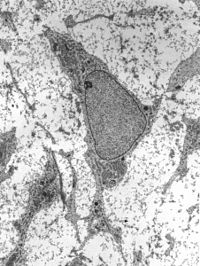
Application of amphiphilic fluorophore-derived nanoparticles to provide contrast to human embryonic stem cells without affecting their pluripotency and to monitor their differentiation into neuron-like cells.
Sign Up to like & getrecommendations! Published in 2018 at "Acta biomaterialia"
DOI: 10.1016/j.actbio.2018.07.051
Abstract: Fluorogenic labeling is a potential technique in biology that allows for direct detection and tracking of cells undergoing various biological processes. Compared to traditional genetic modification approaches, labeling cells with nanoparticles has advantages, especially for… read more here.
Keywords: hes cells; pluripotency; differentiation; embryonic stem ... See more keywords

Constitutive High Expression of NOXA Sensitizes Human Embryonic Stem Cells for Rapid Cell Death.
Sign Up to like & getrecommendations! Published in 2022 at "Stem cells"
DOI: 10.1093/stmcls/sxab008
Abstract: Human embryonic stem (hES) cells are highly sensitive to apoptotic stimuli such as DNA damage, which allows for the rapid elimination of mutated cells during development. However, the mechanisms that maintain hES cells in the… read more here.
Keywords: noxa; hes cells; embryonic stem; constitutive high ... See more keywords

Human Embryonic-Derived Mesenchymal Progenitor Cells (hES-MP Cells) are Fully Supported in Culture with Human Platelet Lysates
Sign Up to like & getrecommendations! Published in 2020 at "Bioengineering"
DOI: 10.3390/bioengineering7030075
Abstract: Human embryonic stem cell-derived mesenchymal progenitor (hES-MP) cells are mesenchymal-like cells, derived from human embryonic stem cells without the aid of feeder cells. They have been suggested as a potential alternative to mesenchymal stromal cells… read more here.
Keywords: medicine; derived mesenchymal; mesenchymal progenitor; hes cells ... See more keywords